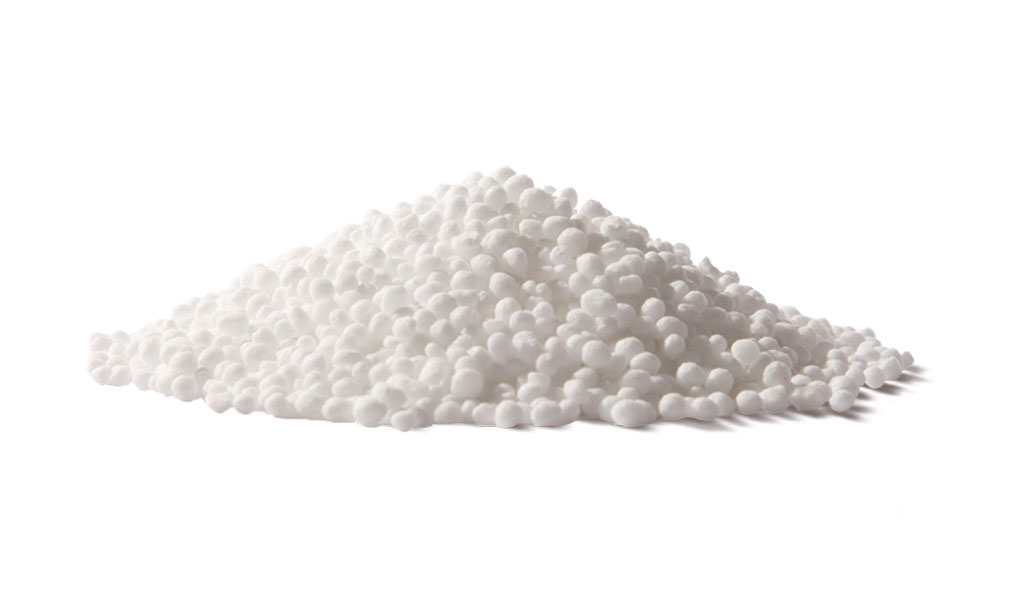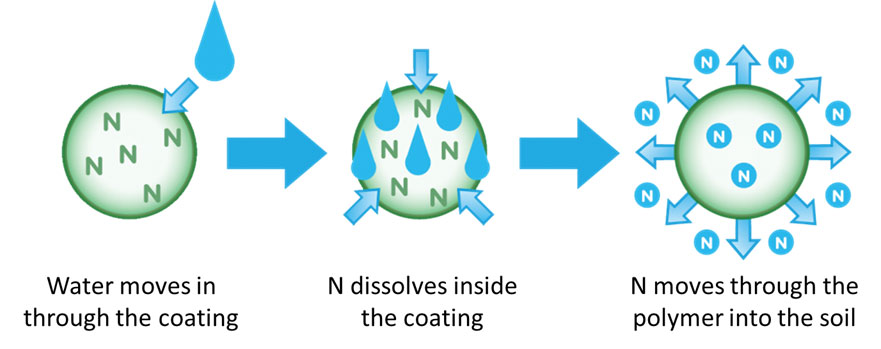PUZZLE PIECES
FINDING A FIT FOR NITROGEN-STABILIZING FERTILIZERS
BY LEE HART
Though nitrogen-stabilizing products are among the newest “old-technology” fertilizers on the market, they are still regarded somewhat cautiously by western Canadian farmers.
Most enhanced efficiency fertilizer (EEF) technology has been around for 15, 20 and even 50 years, but products haven’t been widely adopted on the Prairies. It’s estimated that 10 to 15 per cent of farmers use them to some degree, but visitors to trade shows and agronomist offices still want to know what these products are, what they do and where they fit.
Also known as nitrogen-stabilizing fertilizers, EEF products include granular urea, anhydrous ammonia and even liquid nitrogen that has been treated or encapsulated in such a way as to limit the exposure of the nitrogen to the elements, protecting it from environmental loss until it can be used by the crop, but they use varying protection mechanisms.
Surface-applied fertilizer is perhaps at the greatest risk to such loss, simply disappearing into the air through a process known as volatilization. As well, when nitrogen fertilizer is exposed to heavy, wet soil conditions, it can be lost through a second process known as denitrification. In a third scenario, under high moisture conditions, and particularly in coarse-textured, sandy soils, it can be leached away from the root zone. Stabilizer chemistry can help reduce nitrogen losses in all three situations.
“There are two categories of enhanced efficiency products that pertain to western Canadian farming,” said Rigas Karamanos, an experienced soil fertility specialist and senior agronomist with Koch Agronomic Services. One is polymer-coated urea. The most familiar of these to Prairie farmers is environmentally smart nitrogen (ESN) developed by Nutrien (formerly Agrium).
And then there are the stabilized nitrogen products, which are split into two modes of action. An example of a commonly used urease inhibitor, Agrotain is marketed by Koch Fertilizers. Even more common, nitrification inhibitors include eNtrench and N-Serve produced by Dow AgroSciences as well as SuperU and Agrotain Plus by Koch Fertilizers.
Under certain conditions, nitrogen losses can be substantial. Research has shown as much as 40 per cent of broadcast nitrogen can be lost through volatilization. “On a warm spring day, as much as four to five pounds of nitrogen can be lost daily through denitrification,” said Karamanos, referring to per-acre losses occurring in soils that are poorly drained or waterlogged.
And yet, EEF products have not exactly caught on like wildfire. “The main driver behind the use of these products today is logistics,” said Steve Larocque, a south-central Alberta farmer and crop consultant who operates consulting service Beyond Agronomy in Three Hills. “Most producers who are considering using these products today are looking to get fertilizer applied at some point ahead of seeding and want to reduce their risk of losses.”
For example, Larocque said, where farmers have extensive acres, or where their seeding equipment capacity is limited, they may look to apply nitrogen in a way that insures against its loss. This is done through either a broadcast application in the fall, by banding ahead of seeding, or by shallow banding during the operation.
Karamanos agrees. “The bottom line for most producers is they are looking for operational efficiencies,” he said. “In the last few years, we are seeing more producers choosing to have fertilizer broadcast-applied with floaters. Perhaps they have three tanks on their air-seeding equipment and they’ve got a large number of acres to get seeded. So, they are looking at getting that fertilizer on early, or at least in a separate operation so it speeds up their seeding.”
He points to older but still valid research conducted by Alberta Agriculture and Forestry that shows early, or at least timely, seeding produces the best results—every day that seeding is delayed can reduce yield by one bushel per acre. “And for someone with 7,000, 10,000 or 15,000 acres to seed, that yield loss adds up,” he said.
Separating nitrogen application from the seeding operation can increase seeding efficiency, according to Koch field research. The company compared the seeding efficiency of two systems. One was a three-tank, air-seeding system in which canola seed, phosphate and a urea-sulphur fertilizer blend were all applied at seeding, while in the other, a three-tank system carried phosphate in two tanks and canola seed in the third.
With both approaches, travelling at the same field speed and working the same number of hours, the seeding system that applied canola seed, phosphate and urea was able to seed 2,040 acres in 10 days. The same air-seeding setup that applied canola seed and phosphate only (leaving out the urea) managed to seed 2,016 acres in six days. “That’s a 40 per cent increase in seeding efficiency when the urea-sulphur blend was applied in a separate operation from seeding,” said Karamanos.
As farmers consider their options, he also points out that the cost for a broadcast application of fertilizer is about half the cost of banding fertilizer. Karamanos said it costs about $50 per acre to band fertilizer versus about $25 for broadcasting.
Karamanos noted that in a separate research project led by Prairie universities and other independent research organizations in 2015, it was found that using the enhanced nitrogen efficiency products did improve overall fertilizer efficiency. Under that year’s growing conditions, at 25 sites across Western Canada, Agrotain and SuperU were applied in spring broadcast operations, shallow banded and deep banded.
“The enhanced products do cost more, so producers either have to be able to see they increase yield or that they can achieve the same yield with reduced input costs,” he said. “This research illustrates that Agrotain and SuperU increased nutrient availability, resulting in statistically the same yield at 70 per cent of the recommended rate compared to 100 per cent of the recommended rate of untreated urea.”
Andrew Lawson, Alberta and B.C. ESN marketing rep for Nutrien, said demonstrating the value of the EEF products to farmers is important. “ESN is a premium nitrogen product that does cost more than conventional nitrogen, so producers need to be able to see value in the product.”
Lawson said ESN is a polymer-coated urea and can be fall applied and ideally incorporated, or spring banded right in the seed row or beside the seed as part of the fertilizer blend. Once the product is applied in or on the soil, moisture will move in through the polymer coating and dissolve the urea inside. As the soil warms, the nitrogen—being temperature sensitive—diffuses out through the porous polymer membrane. As moisture levels and soil temperatures change, nitrogen is gradually released for up to 80 days.
“We are positioning it as a broad-acre product that can be used with all cereals and oilseeds including canola and flax,” he said. “Some producers have used it, for example, with wheat crops on sandy soils with the intent of boosting protein yield. And that does have a fit, but it can be used with all crops and provide an economic return.”
Lawson said on-farm trials have consistently shown every dollar spent on ESN can produce a $3 net return through higher yield with canola. In wheat, he said it similarly produces a 2.5-to-one to three-to-one return on investment while protecting against all three nitrogen-loss mechanisms.
He also points out ESN’s flexibility. If applied in fall, it won’t release into cold or frozen ground. If wet soil conditions prevail, the polymer coating reduces nitrogen leaching. And under drier conditions, it conserves nitrogen until sufficient moisture is available.
Lawson said seed safety is also one of the benefits of ESN when banded in the seed row with the fertilizer blend, and added that ESN can be applied at a rate up to three times higher than provincial recommendations for straight urea, depending on the opener and seeding tool.
Rory Degenhardt, Dow AgroSciences research scientist, said nitrogenstabilizing products such as eNtrench and N-Serve have the best fit in areas where moisture and environmental conditions are most conducive to nitrogen loss. “In higher rainfall areas, leaching and denitrification can be an issue,” he said. “And it can also be a concern on irrigated land in the brown soil zone. Losses can vary from area to area and from year to year, but losses in the 10 to 50 per cent range are not uncommon.”
With the novel micro-encapsulated formulation of eNtrench, it can be impregnated on urea or mixed with UAN or liquid manure. Both eNtrench and N-Serve products are designed to do the same thing, which is to slow the conversion of ammonium nitrogen to the nitrate form. Product research shows the use of N-Serve or eNtrench can reduce leaching losses by 16 per cent, and denitrification losses—which produce greenhouse gases—by 51 per cent.
Field-scale trials in 2015 found, on average, 44 per cent more positive ammonium was available for the crop two weeks after emergence when N-Serve or eNtrench nitrogen stabilizers were used, compared with unprotected nitrogen. Keeping more nitrogen in the positive form protects it from loss. Yield data showed that crops grown where nitrogen was protected yielded higher—3.8 bushels more per acre for canola and 3.7 bushels more per acre for spring wheat and durum.
Degenhardt said the stabilizers in eNtrench protect nitrogen over winter and will break down in the spring, usually having some influence until early to mid-June.
Convincing more farmers to try EEF products is a gradual process, said Nutrien agronomist Ray Dowbenko, who has worked with ESN since its introduction to the Canadian market in 2005. He noted that there have been many research and on-farm trials over the past 20 years, but uptake by the industry has been slow. “In many respects, the adoption of these products is in its infancy,” he said. “Producers are still asking what are they and where do they fit. All of these enhanced efficiency products work, they do what they say they will do, but so often it depends on growing conditions. The weather is the big qualifier.”
Larocque urges producers to do a cost-benefit analysis. “Depending on field and growing conditions, research results with nitrogen-stabilizer products has been quite variable,” he said. “Some years there is a response, and some years there isn’t.
“The first thing for farmers to consider is, what is their risk? They need to understand the nitrogen cycle and determine where they are at highest risk of losing nitrogen. Do they broadcast-apply nitrogen in the fall, which could increase the risk of volatilization? Do they have to deal with high soil moisture conditions in spring, which could increase the risk of denitrification? Do they farm sandy soils where leaching might be a concern?”
The question is, according to Larocque, with these enhanced nitrogen efficiency products costing anywhere from eight to 12 cents per pound of nitrogen (for many crops, that’s $8 to $14 per acre), is the farmer seeing a payback in increased yield?
Larocque said products might have greater value for producers looking to spread out workload by applying fertilizer in the fall. Because the fertilizer sits in the elements for about eight months, it may need some extra protection.
He questioned the level of risk present during the much narrower window for spring-applied products. “So, again, how often does the producer have extreme conditions during that six-week window between seeding and peak nitrogen demand where an extra outlay for input costs is necessary?”
Larocque said there are areas across Western Canada prone to waterlogging for short durations or leaching in coarse-textured soils where nitrogen-stabilizing products provide a good return. He also said if farmers are aiming to shallow band fertilizer less than 1.5 inches, research has shown that volatilization can still occur. Placing nitrogen this shallow increases the risk of nitrogen loss. “And where the risk is higher, using these products makes sense,” he said.
He added that some farmers have been using nitrogen-stabilizing products with variable rate application. For example, when using anhydrous ammonia, applying a product like N-Serve with a direct-injection pump in zones with lower elevation can reduce the risk of nitrogen loss from denitrification and reduce overall cost.
Larocque believes that, given the proper soil and/or moisture conditions, these products can be very effective. But he does encourage farmers to consider how frequently the conditions for nitrogen loss exist between application and peak demand. Understanding at which point in the nitrogen cycle you are at greatest risk of losing nitrogen will help determine which stabilizer is appropriate and produces a return on investment.








Comments